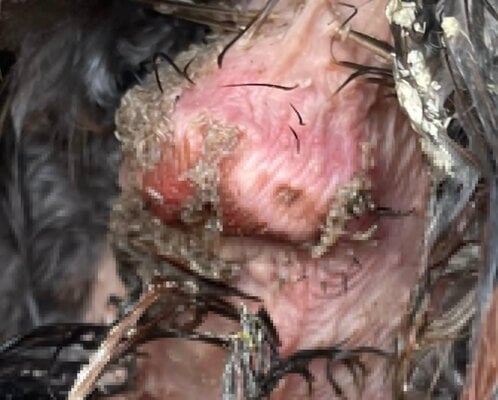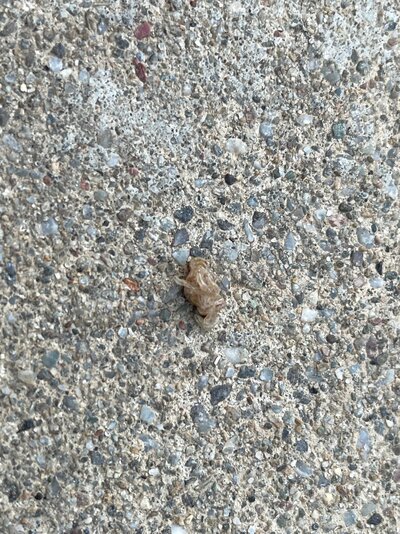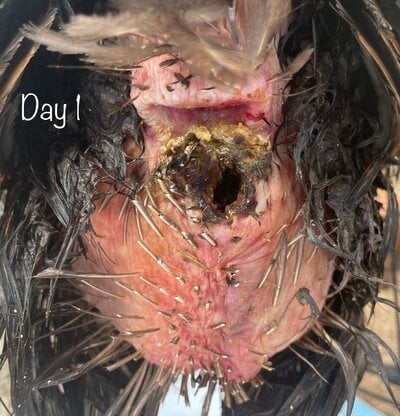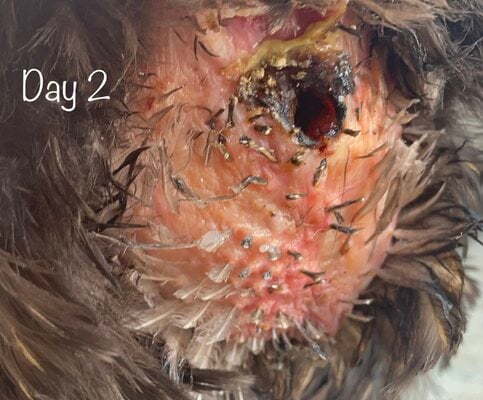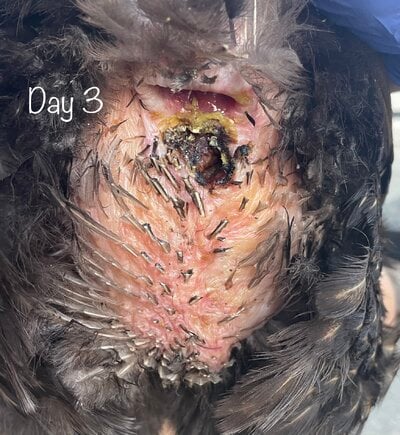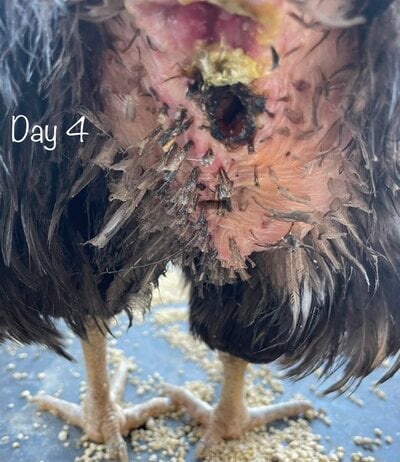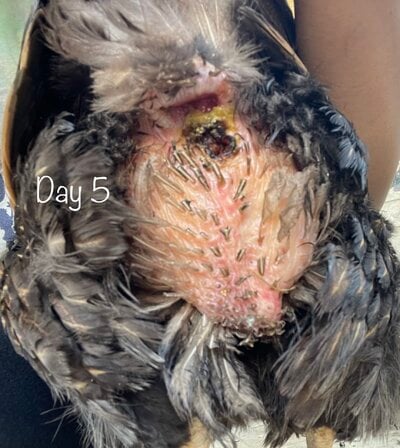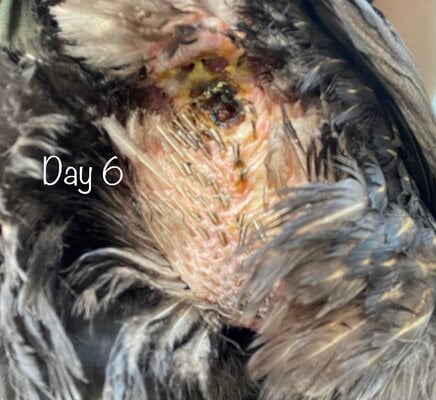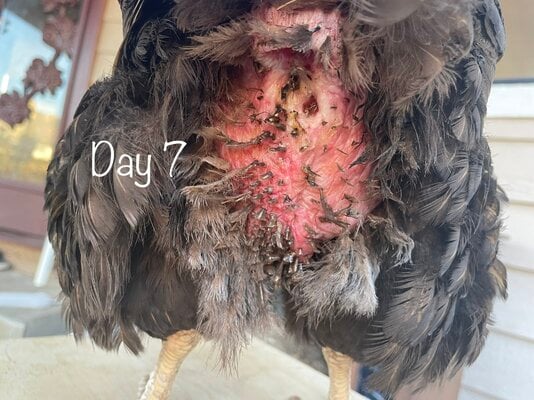Hello! Today I decided to write about my journey dealing with flystrike. I have dealt with it several times in the past, some severe and some less severe.
First off, I want to thank @Wyorp Rock for helping me when I was still new to flystrike myself!
- What is Flystrike?
Flystrike is when a chicken gets infested with maggots. Maggots are basically fly babies. They can hatch in under 24 hours when in the correct environment (humid and hot). When they are a few days old, they appear to be clear and larva-like. As they grow, they become less and less transparent and more white. When flies lay their eggs on a chicken, and they hatch, the maggots feast on the chicken, causing wounds. Flies prefer to lay their eggs under vents or in/near wounds.
- Causes
There are a few causes of flystrike. One of which is poop. When poop gets stuck on the feathers underneath the vent, it attracts flies. Flies like dark and moist areas, which makes dirty chicken bums extremely attractive to them. The second area that flies like to lay their eggs at are on chicken wounds. That's why its so important to watch a chicken with wounds, especially during warmer weather (when flies are out and about).
The second area that flies like to lay their eggs at are on chicken wounds. That's why its so important to watch a chicken with wounds, especially during warmer weather (when flies are out and about).
- Prevention
There are a few ways to prevent flystrike. The main way is to control the fly population. Fly traps work well, but I recommend against getting fly paper as birds can get stuck in it themselves. Also make sure to keep up with poop. Poofier breeds like Brahmas, Orps, and Cochins can get dirtier bums easier as well. My best tip for poop management is to cut off some of the feathers under the vent. I like to cut up to an inch under the vent. Baths work as well, but its not realistic to bathe them that often. Other than that, discovering flystrike as early as possible is going to be a big advantage.
- Treatment
1.) Soak the bird in warm water with some dish soap in it (cool water works as well, but can stress the bird out. No dish soap can work as well). I like to use a bucket for soaks.
2.) Take the bird out and wrap her/him with a towel to keep their wings to themselves. During this time, pick out ANY maggots left behind with tweezers.
3.) Cut off any feathers in the way, to get a better view, if needed.
4.) I also recommend creating a thread here on BYC, as every case is different.
5.) Cover the wound in original Neosporin without any pain killer or spray the wound with veterycin.
6.) Keep the bird in a fly-proof container. I used a snake habitat with ventilation over the top. If flies can’t get in, it would be best.
7.) Keep checking and picking out any maggots you might’ve missed DAILY, as well as applying antibacterial cream/spray.
8.) Repeat the steps until the wounds are healed.
- My journey
I have personally dealt with flystrike several time. Once with an EE and several times with Wyandotte’s. For the first case, I was able to find the maggots early, so the maggots haven’t done a lot of damage yet. I wasn’t so lucky for the other cases. I will start by talking about the first bird, an EE.
For the first time, I soaked the bird 2 times, I believe. Those 2 cleanups were enough to keep the maggots away. I kept the EE in a fly proof container and I didn't use any antibacterial creams or sprays for this bird. Her wounds healed quickly, since I caught her case fast. Unfortunately, we lost her soon after, due to a reproductive issue.
And for the for the next case I dealt with, a GLW of mine got flystrike. She wasn’t as fortunate as my EE and seemed to already have the maggots for quite a few days by the time I found out. I soaked her once, and cleaned out her wound 2-3 times a day. I cleaned out the wound by using a hydrogen peroxide mixture. It was
9ml of hydrogen peroxide and 3ml of water each time. I flushed her wound with this mixture 3 times a day for two days, 2 times a day for 7 days and then once a day for 3-4 days. All of which were done with a 12ml syringe. She joined her flock on the 8th day, but before that, I already brought her out to see her flock a few times. This was to prevent any issues I might have if I chose to integrate her back after 8 days of not seeing her flock at all. She has since started laying again and is now 7-8 years old. I didnt have Vetericyn or Original Neosporin during that time period, but I definitely recommend those two, opposed to hydrogen peroxide.
The other cases I have dealt with are also extremely similar to the two cases above. The only exception is that I used neosporin and Veterycin, which are both really great for wounds.
I have added a few example pictures of wounds and of maggots. There is also a day to day on my GLW's journey.
First off, I want to thank @Wyorp Rock for helping me when I was still new to flystrike myself!
- What is Flystrike?
Flystrike is when a chicken gets infested with maggots. Maggots are basically fly babies. They can hatch in under 24 hours when in the correct environment (humid and hot). When they are a few days old, they appear to be clear and larva-like. As they grow, they become less and less transparent and more white. When flies lay their eggs on a chicken, and they hatch, the maggots feast on the chicken, causing wounds. Flies prefer to lay their eggs under vents or in/near wounds.
- Causes
There are a few causes of flystrike. One of which is poop. When poop gets stuck on the feathers underneath the vent, it attracts flies. Flies like dark and moist areas, which makes dirty chicken bums extremely attractive to them.
 The second area that flies like to lay their eggs at are on chicken wounds. That's why its so important to watch a chicken with wounds, especially during warmer weather (when flies are out and about).
The second area that flies like to lay their eggs at are on chicken wounds. That's why its so important to watch a chicken with wounds, especially during warmer weather (when flies are out and about).- Prevention
There are a few ways to prevent flystrike. The main way is to control the fly population. Fly traps work well, but I recommend against getting fly paper as birds can get stuck in it themselves. Also make sure to keep up with poop. Poofier breeds like Brahmas, Orps, and Cochins can get dirtier bums easier as well. My best tip for poop management is to cut off some of the feathers under the vent. I like to cut up to an inch under the vent. Baths work as well, but its not realistic to bathe them that often. Other than that, discovering flystrike as early as possible is going to be a big advantage.
- Treatment
1.) Soak the bird in warm water with some dish soap in it (cool water works as well, but can stress the bird out. No dish soap can work as well). I like to use a bucket for soaks.
2.) Take the bird out and wrap her/him with a towel to keep their wings to themselves. During this time, pick out ANY maggots left behind with tweezers.
3.) Cut off any feathers in the way, to get a better view, if needed.
4.) I also recommend creating a thread here on BYC, as every case is different.
5.) Cover the wound in original Neosporin without any pain killer or spray the wound with veterycin.
6.) Keep the bird in a fly-proof container. I used a snake habitat with ventilation over the top. If flies can’t get in, it would be best.
7.) Keep checking and picking out any maggots you might’ve missed DAILY, as well as applying antibacterial cream/spray.
8.) Repeat the steps until the wounds are healed.
- My journey
I have personally dealt with flystrike several time. Once with an EE and several times with Wyandotte’s. For the first case, I was able to find the maggots early, so the maggots haven’t done a lot of damage yet. I wasn’t so lucky for the other cases. I will start by talking about the first bird, an EE.
For the first time, I soaked the bird 2 times, I believe. Those 2 cleanups were enough to keep the maggots away. I kept the EE in a fly proof container and I didn't use any antibacterial creams or sprays for this bird. Her wounds healed quickly, since I caught her case fast. Unfortunately, we lost her soon after, due to a reproductive issue.
And for the for the next case I dealt with, a GLW of mine got flystrike. She wasn’t as fortunate as my EE and seemed to already have the maggots for quite a few days by the time I found out. I soaked her once, and cleaned out her wound 2-3 times a day. I cleaned out the wound by using a hydrogen peroxide mixture. It was
9ml of hydrogen peroxide and 3ml of water each time. I flushed her wound with this mixture 3 times a day for two days, 2 times a day for 7 days and then once a day for 3-4 days. All of which were done with a 12ml syringe. She joined her flock on the 8th day, but before that, I already brought her out to see her flock a few times. This was to prevent any issues I might have if I chose to integrate her back after 8 days of not seeing her flock at all. She has since started laying again and is now 7-8 years old. I didnt have Vetericyn or Original Neosporin during that time period, but I definitely recommend those two, opposed to hydrogen peroxide.
The other cases I have dealt with are also extremely similar to the two cases above. The only exception is that I used neosporin and Veterycin, which are both really great for wounds.
I have added a few example pictures of wounds and of maggots. There is also a day to day on my GLW's journey.

